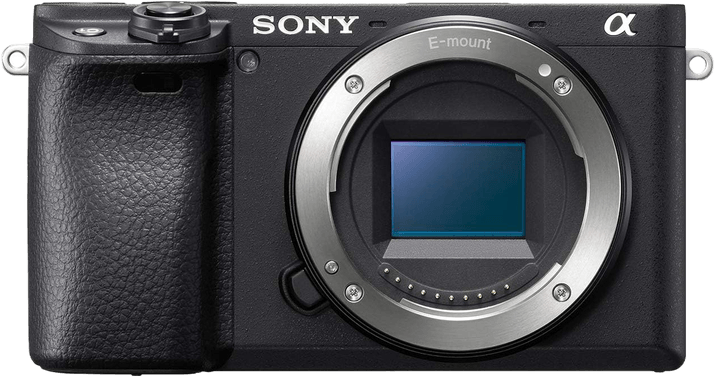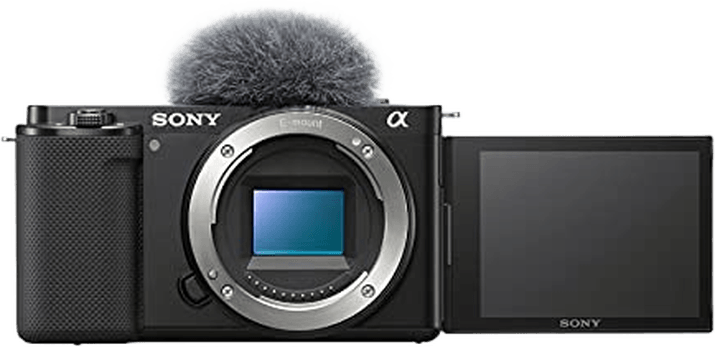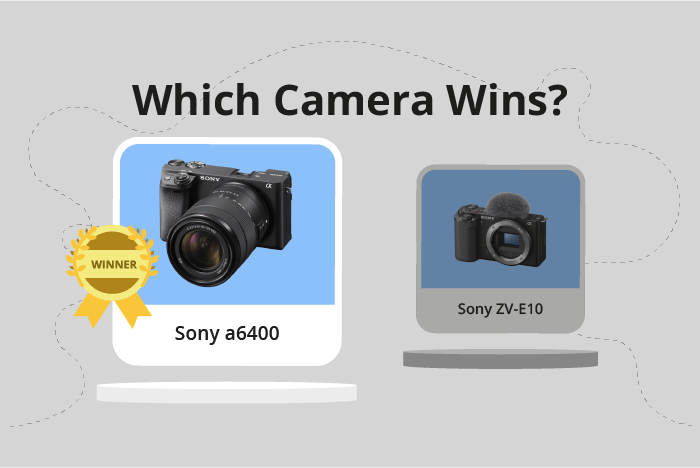Sony a6400 vs ZV-E10 Comparison
Sony a6400

Sony ZV-E10

The Sony a6400 emerges as the winner with a score of 70/100, while the Sony ZV-E10 trails behind with 65/100. Both cameras are mirrorless and were announced in 2019 and 2021, respectively. They share similarities in launch prices, with the a6400 at $900 and the ZV-E10 at $700.
The a6400 excels with its larger size (120 x 67 x 60mm) and weight (403g), offering a more substantial feel and better grip. On the other hand, the ZV-E10 is more compact (115 x 64 x 45mm) and lighter (343g), making it ideal for those who prioritize portability.
Despite the differences in scores, both cameras have their advantages. The Sony a6400 is better suited for users seeking a more robust and ergonomic design, while the Sony ZV-E10 is perfect for those who value a lightweight and portable camera. Choose the one that best fits your needs and preferences.
Sony a6400 vs ZV-E10 Overview and Optics
The Sony ZV-E10 wins the optics comparison with a score of 69/100, while the Sony a6400 scores 68/100. Both cameras have 24-megapixel CMOS sensors, 11 fps shooting speeds, Bionz X processors, APS-C sensor sizes, Sony E lens mounts, and lack image stabilization. They also share the same aspect ratio of 3:2.
The ZV-E10’s higher score is due to its better DXOMARK sensor score of 86, compared to the a6400’s score of 83. This means the ZV-E10 provides higher image quality and better low-light performance. Additionally, the ZV-E10 has a 4:3 aspect ratio, offering more flexibility in post-processing and cropping. This makes it a better choice for photographers who want to maximize their camera’s potential in various shooting scenarios.
On the other hand, the a6400 has a slight advantage in megapixels, with 24.2 compared to the ZV-E10’s 24. This minor difference may result in slightly more detailed images, but it is not a significant factor in overall image quality. Both cameras have the same shooting speed, lens mount, and sensor type, so there are no major differences in these areas.
When considering optics, the Sony ZV-E10 is the better choice due to its higher DXOMARK sensor score and more flexible aspect ratio. The Sony a6400’s slight advantage in megapixels does not make up for these differences. Photographers should choose the ZV-E10 for better image quality and versatility, while the a6400 can still be a reliable option for those who prioritize a slightly higher megapixel count.
Sony a6400 vs ZV-E10 Video Performance
The Sony a6400 and Sony ZV-E10 both achieve a video score of 91/100, indicating that their video capabilities are quite similar. Both cameras offer 4K video resolution, with the a6400 having video dimensions of 3840 x 2160, while the ZV-E10 has slightly lower dimensions at 3840 x 1920. Additionally, both cameras support a maximum video frame rate of 120fps and have built-in time-lapse functionality.
The winning camera in terms of video dimensions is the Sony a6400, as it offers a slightly higher video resolution, which results in better overall image quality. This advantage may be important for users who require the highest possible video quality for their projects.
On the other hand, the Sony ZV-E10 matches the a6400 in most video specifications, including maximum frame rate and time-lapse functionality. Considering the equal video score of both cameras, the ZV-E10’s slightly lower video dimensions might not significantly impact its overall video performance.
In comparing the video capabilities of the Sony a6400 and Sony ZV-E10, it is evident that both cameras offer strong performance in this area. The a6400 has a slight edge with its higher video dimensions, but the ZV-E10 remains competitive by matching the a6400 in other key specifications. Ultimately, users should consider other factors such as price, form factor, and additional features when choosing between these two cameras, as their video capabilities are largely similar.
Sony a6400 vs ZV-E10 Features and Benefits
The Sony a6400 emerges as the winner in the feature comparison, scoring 81/100, while the Sony ZV-E10 trails behind with a score of 68/100. Both cameras share several specifications, including a 3-inch screen size, touchscreen capabilities, flip screens, GPS absence, and WIFI and Bluetooth connectivity.
The a6400 surpasses the ZV-E10 with its higher screen resolution of 921,600 dots compared to the ZV-E10’s 920,000 dots. This difference provides the a6400 with a slightly clearer and sharper display, enhancing user experience and making it easier to review images and videos.
However, the ZV-E10 still possesses some advantages despite its lower score. For instance, the ZV-E10’s lower score does not necessarily mean it has inferior features. Both cameras still have the same screen size and connectivity options, making them suitable for various photography and videography needs.
Considering each point, the Sony a6400’s higher feature score and screen resolution give it an edge over the ZV-E10. Nonetheless, both cameras have similar core specifications, making them capable choices for photographers and videographers. Ultimately, the choice between the two cameras will depend on individual preferences and specific requirements.
Sony a6400 vs ZV-E10 Storage and Battery
The Sony a6400 outperforms the Sony ZV-E10 in storage and battery, with a score of 37/100 compared to the ZV-E10’s 24/100. Both cameras have one memory card slot and accept SD, SDHC, and SDXC cards, as well as Memory Stick Duo cards. They also share the same battery type, the NP-FW50.
The a6400’s advantage lies in its USB charging capability, which the ZV-E10 lacks. This feature allows users to recharge the camera more conveniently, making it a better choice for those who need to charge on-the-go or have limited access to power outlets.
On the other hand, the ZV-E10 has a slightly longer battery life, offering 440 shots compared to the a6400’s 410 shots. This difference, however, might not be significant enough to sway users, especially considering the a6400’s USB charging feature.
Taking these factors into account, the Sony a6400 proves to be the superior choice in terms of storage and battery performance. The added convenience of USB charging outweighs the ZV-E10’s marginally longer battery life, making the a6400 a more practical option for most users.
Alternatives to the Sony a6400 and ZV-E10
Are you still undecided about which camera is right for you? Have a look at these popular comparisons that feature the Sony a6400 or the Sony ZV-E10:

